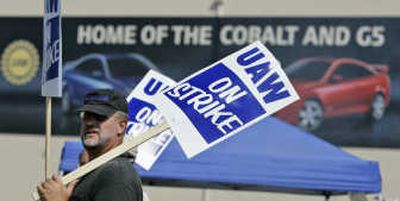GM, union may be close to a deal

DETROIT – Negotiators bargained until the early hours this morning and were close to reaching a contract agreement that would end a nationwide strike by 73,000 workers, two people who were briefed on the talks said.
The two sides began work Tuesday morning and were talking into the night in an effort to halt the strike, which started at 11 a.m. Monday at about 80 GM facilities across the country.
Both of the people requested anonymity because the talks are private. One said negotiating teams were working out “small details,” while the other said that work was almost wrapped up on an innovative plan for the company to pay the union to form a trust and take over responsibility for retiree health care.
But Tuesday night, picketers remained at the GM factories and other facilities, although several industry analysts said they expected the walkout to be short.
A 1970 strike against GM went on for 69 days and helped push the nation into a recession, but industry watchers didn’t think that would happen this time.
Both sides have something the other desires – the workers want job security, GM wants the union to take on the burden of retiree health care – and that’s the stuff that agreements are made of.
“The UAW and GM understand that a strike is a lose/lose proposition,” Deutsche Bank analyst Rod Lache said Tuesday in a note to investors.
Talks broke off Monday when the strike began, but resumed in the afternoon and continued into the evening when weary bargainers broke for a rest. Analysts were encouraged that the talks have continued throughout the strike.
The union said it went on strike largely because GM failed to make promises for future products and investment in U.S. plants. GM said it was disappointed and would work with the UAW to address its competitive challenges.
“I’m hoping we get a fair contract. I understand that General Motors has their back against a wall. But I don’t want to give them everything,” said autoworker Ernie Bruton, who was picketing Tuesday outside a GM engine plant in the Detroit suburb of Romulus.
Wall Street was taking a wait-and-see approach. GM shares slipped 32 cents, or less than 1 percent, to close at $34.42 Tuesday.
In 1970, the UAW’s strike against GM rippled through the economy. Production declined, unemployment rose and retail auto sales dried up, according to an analysis by Merrill Lynch. A 54-day strike against two GM plants in 1998 wreaked similar havoc and cost GM $2.2 billion.
This strike already is having an impact at non-UAW-represented GM plants and at suppliers.
On Tuesday, GM idled two car assembly lines employing about 5,600 people at its plant in Oshawa, Ontario. On Monday, it idled a transmission plant in Windsor, Ontario, that employs 1,300. Workers at both are represented by the Canadian Auto Workers union.
Parts shortages forced GM to cancel one shift Tuesday at a Moraine, Ohio, assembly plant that makes sport utility vehicles. The plant’s 2,300 workers are represented by the International Union of Electronic Workers-Communication Workers.
Delphi Corp., GM’s largest supplier, said Tuesday it was temporarily laying off workers. Spokesman Lindsey Williams wouldn’t give numbers because the situation was in flux. Delphi has about 25 U.S. plants that supply parts for GM.
Still, industry watchers predict the strike’s impact will be minimal. Goldman Sachs auto analyst Robert Barry said if the UAW had planned a long strike, it would have struck one or two key plants. The UAW is paying striking workers $200 a week from its $800 million strike fund.
“In our view, the action is designed to allow UAW leaders to look vigilant in fighting to preserve benefits, members to feel concessions are not being given gratuitously, and GM management to appear to be maximizing shareholder value,” Barry said in a note to investors.
Any agreement would have to be ratified by the UAW’s members who work for GM.
The retiree health care trust could save GM an estimated $3 billion per year, Lache said, making it more competitive with Asian automakers who have fewer U.S. retirees and insulating it from health care inflation. UAW President Ron Gettelfinger said Monday the union is considering the trust, called a Voluntary Employees Beneficiary Association, or VEBA.
The union’s quest to preserve jobs through guarantees that new cars and trucks will be built at U.S. factories clashes with GM’s need to close plants to match demand for its products, said Greg Gardner, an analyst for Harbour Consulting, a Troy company that tracks manufacturing productivity.
Most of the discussion probably centers on plants that build small- and mid-sized cars such as Lordstown, Ohio; Kansas City, Kan.; and Orion Township, Mich., Gardner said.
The profit margins on those vehicles are so slim that it makes more business sense to produce them in places with lower labor costs, like Mexico, said Erich Merkle, vice president of auto industry forecasting for consulting company IRN Inc. in Grand Rapids.
GM needs the flexibility to close plants when demand for a certain product drops, Gardner said. Currently the company must pay workers most of their wages when they are laid off.
Many analysts expect the automaker will have to make concessions in order to get the VEBA.